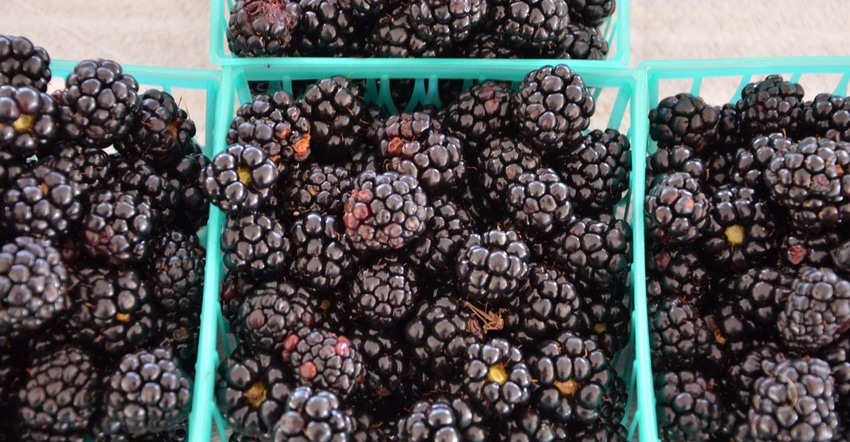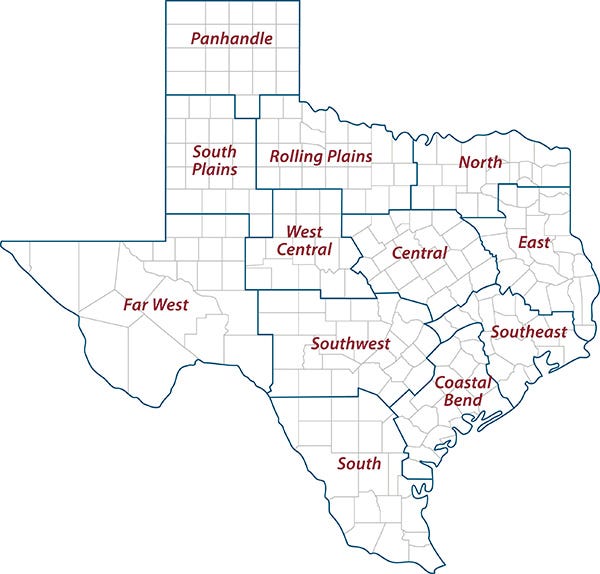
Harvest has been peachy so far for fruit producers this season, according to a Texas A&M AgriLife Extension Service expert.
Dr. Larry Stein, AgriLife Extension fruit specialist, Uvalde, said late freezes, spring storms and heavy rains have not negatively affected most orchards and warm-season fruit varieties this season. Peach and blackberry producers around the state have been reporting above-average yields and quality.
“The freezes thinned some early varieties, but the late-producing varieties still needed thinning,” he said. “The crop looks good.”
Peach growers in the Hill Country region began harvesting in May and later-producing varieties are typically available through August, Stein said. Harvest of varieties in North and East Texas is in full swing, and peaches should be available at local markets through Labor Day.
Stein said high moisture levels required growers be vigilant regarding fungal and bacterial diseases, but there were no reports of major losses attributed to outbreaks. Some orchards reported heavy stinkbug infestations, which required more attention than is typical.
“Stinkbugs are hard to control,” he said. “When they feed on young fruit, they can deform it. We call it ‘cat-faced’ because they’re scarred-up looking.”
Rains were spotty, delivering high volumes to some areas and not much to others, Stein said. But the overall moisture levels also make Stein optimistic about next year.
“In years where trees are under drought stress in June and July during flower initiation we typically see a lot of doubles the next year,” he said. “Doubles are when the tree produces two flowers per bud – twin peaches – so you have two small peaches rather than one big peach. It lessens size and quality. The moisture conditions are good, so theoretically there is less chance of that happening next year.”
This season is shaping up as a good one for consumers as wells, Stein said. The U.S. Department of Agriculture Agricultural Marketing Service reported peaches in the South Central U.S., which includes Texas, were comparable to last year.
Retail prices were $1.56-$2.98 per pound compared to $1.95-$2.99 per pound in 2018, according to the service’s June reports.
“The market is good,” Stein said. “Sellers are getting their prices, but based on the quality, the consumers are getting a good deal as well. There should be no shortage of good fruit for cobblers and canning and preserves.”
AgriLife Extension district reporters compiled the following summaries:

The 12 Texas A&M AgriLife Extension Districts
CENTRAL
Conditions were wet. Wheat harvest was good thus far with yields ranging from 50-80 bushels per acre. Corn was off to a good start and continued to grow with some terrace channels struggling due to excess water. Cotton fields started well with good soil moisture. Pastures and hay fields looked promising. Native grasses looked good. Cattle were in good body condition, and stock tanks were full. Ground temperature was slow to reach 73 degrees. Conditions were starting to dry down in some areas, and hay harvest was underway.
ROLLING PLAINS
Conditions were favorable with temperatures continuing to climb. Topsoil moisture was still good. Cotton producers started to plant. Area wheat producers baled wheat hay, while other producers were ready for grain harvest. Livestock were in good condition as pastures and rangelands continued to improve.
COASTAL BEND
Dry weather was reported in the southern end of the district, and some much-needed rain fell in the mid-to-northern part. Crops were progressing well but could use a good soaking rain. Grass and weeds were being sprayed in cotton and beans. Some corn was beginning the dry-down phase. Most grain sorghum was flowering and/or beginning to set seed. Some hay was being baled. Pastures were in good condition and being sprayed for weeds. Livestock were doing well. Pecans were off to a promising start.
EAST
The district received spotty rains. Temperatures were rising, which caused grass production to improve. Pasture and rangeland conditions were fair to good with subsoil and topsoil mostly adequate and a few counties reporting surplus. Trinity County received up to 1.5 inches of rain. Producers were spraying weeds, baling and fertilizing hay. Hay production was in full swing in Cherokee County. Producers were baling silage instead of dry hay due to wet conditions. Producers in Houston and Sabine counties were able to get their first cutting of hay baled. In Houston County, calves were lower quality, and the cattle market dipped again. Prices were solid on cattle in Shelby County. Livestock were doing well in Smith and Trinity counties. Wild pigs continued to be destructive, and control was underway in several counties.
SOUTH PLAINS
Most counties received rain, which helped subsoil and topsoil tremendously. Some counties reported standing water, including drowned-out cotton acres, and those acres were expected to be replanted. Some counties missed rain and needed moisture to finish planting. Some cotton was not germinating or was being stressed by seedling disease. Hay producers were able to get their first hay cuttings cured, baled and stored. Pasture, rangeland and winter wheat remained in fair condition. Producers continued to plant. Cattle were in good condition.
PANHANDLE
Cotton, peanut and other warm-season crops were being planted. Cattle and pasture conditions looked very good. Planted cotton did not germinate. Wet conditions in some counties prevented planting. Many cotton fields were optioning to grain plans due to the amount of moisture received. Rangelands were in their best condition in years.
NORTH
Soil moisture was adequate to surplus in most counties. Continued storms were keeping soil moisture high. Average rainfall for the reporting period ranged from 2-6 inches. Flooded fields were reported in Hopkins County. Corn planted early looked good, and later corn was adequate. Winter wheat looked good, but if wet conditions continue, harvesting pastures may be a problem. Some producers were able to harvest wheat due to a small window of dry weather, but much remains in fields. Cotton producers continued to wait for drier conditions to begin planting. Very few acres were planted so far. Sorghum was not looking good due to persistent wet, cooler conditions. There were a few soybean fields planted, but they don’t look good so far. There was a lot of hay baled between rainstorms the last several weeks. Winter grasses were good this year, and bale counts were high. Cattle looked good, and there were still many stockers in pastures cleaning up winter grasses. Calves were gaining well. Wild pigs were very destructive, tearing up cemeteries, yards, pastures and hayfields. Trappers were catching high numbers of wild pigs.
FAR WEST
Temperature highs were in the low 90s with lows in the mid-60s. Severe storms in the far western part of the district brought 0.5-4.5 inches of rain, golf ball-sized hail, damaging winds and threats of tornadoes. Corn and sorghum were making very good progress with warmer temperatures. Many corn fields were expected to begin tasseling soon. Hay grazer was still being planted, and the wheat harvest was wrapping up. A lot of cotton was planted. A handful of producers were replanting a few fields with some emergence issues, mostly due to rainfall. Watermelons were starting to grow. Pecan trees dropped their catkins. Pecan producers sprayed for pecan nut casebearer and still have traps out to monitor for the second flight. Jumbo grasshoppers were reported. Rangelands were recovering well with cooler temperatures and moisture. Livestock and rangeland conditions were fair.
WEST CENTRAL
Most of the district received several more inches of rain. The district was dealing with lots of excess moisture in fields. Some producers were able to cut wheat. Cotton planting was way behind schedule. Livestock were doing well. Weeds continued to be a major problem for producers. All classes of livestock were in mostly good condition. Sheep and goat producers were battling internal parasites. Demand at sale barns was very good.
SOUTHEAST
Some parts of the district reported rain. Rains will make planting rice before the final planting date difficult. Some rice was harvested. Livestock were in good health. Pastures were progressing well for forage production. In Lee County, pastures and fields were starting to dry out. Hay was being cut. Rangeland and pastures were excellent to poor with good conditions being most common. Soil moisture levels ranged from adequate to surplus with adequate being most common.
SOUTHWEST
Some counties reported trace amounts to 4.75 inches of rain. Counties that received rain were seeing improved rangeland and pasture conditions. Counties without rainfall reported a decline in conditions. Wheat harvest was wrapping up with good yields reported. Corn, sorghum and cotton looked good. Some counties reported weather conditions made hay baling difficult, as heavy winds made raking a challenge. Livestock were in fair to good shape.
SOUTH
Northern parts of the district reported warm weather conditions with short to adequate soil moisture levels. Western parts of the district reported mild weather with rains and adequate soil moisture levels. Eastern parts of the district reported dry, windy weather with short to adequate soil moisture levels. Warm weather conditions and short soil moisture levels were reported in the southernmost part of the district. Atascosa County reported windy conditions but perfectly timed rains. Potatoes, wheat and sweet corn were harvested. Peanut planting continued, and cotton was squaring and a week to 10 days from first bloom. Corn fields were silking. Pasture and rangeland conditions were fair to good. Live Oak County reported declining row crop and pasture conditions due to lack of rainfall. Coastal Bermuda grass fields in Maverick County were producing very good hay bales. Watermelons and cantaloupes were also in good shape with well-developed produce. Zavala County reported heavy rains and surplus moisture. Native rangelands and pastures should respond well and provide good, quality forage for grazing. Wheat harvest neared completion. Cabbage and onion harvests were completed. Sorghum and cotton made good progress. Very little supplemental feeding of livestock was reported. Producers in Zapata County reported supplemental feeding and stocking rate changes due to dry, hot and windy conditions. Other counties reported similarly declining pasture conditions due to heat and wind.
Source: is AgriLife TODAY, which is solely responsible for the information provided and is wholly owned by the source. Informa Business Media and all its subsidiaries are not responsible for any of the content contained in this information asset.
About the Author(s)
You May Also Like




